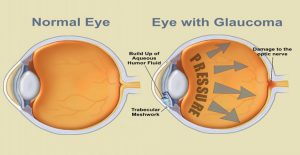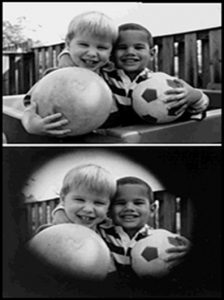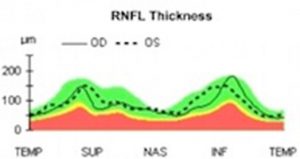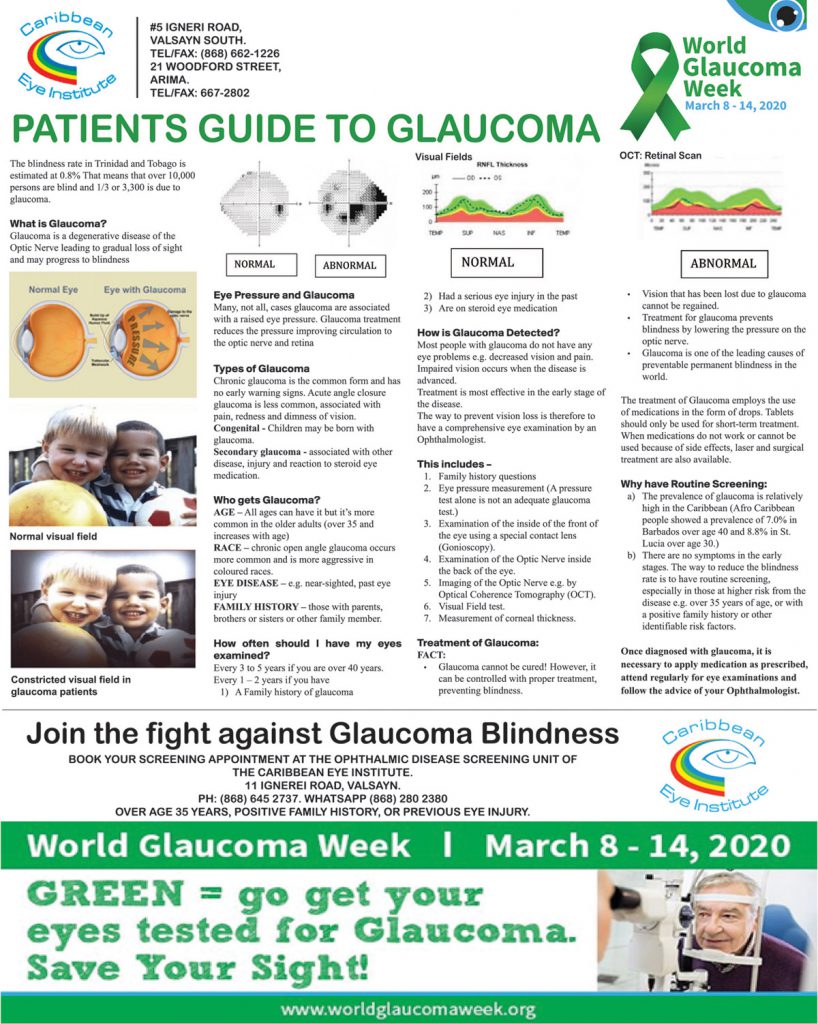The blindness rate in Trinidad and Tobago is estimated at 0.8% That means that over 10,000 persons are blind and 1/3 or 3,300 is due to glaucoma.
What is Glaucoma?
Glaucoma is a degenerative disease of the Optic Nerve leading to gradual loss of sight and may progress to blindness
Eye Pressure and Glaucoma:
Many, not all, cases glaucoma are associated with a raised eye pressure. Glaucoma treatment reduces the pressure improving circulation to the optic nerve and retina

Top – normal visual field
Bottom – constricted visual field in glaucoma patients

Types of Glaucoma?
Chronic glaucoma is the common form and has no early warning signs.
Acute angle closure glaucoma is less common, associated with pain, redness and dimness of vision.
Congenital – Children may be born with glaucoma.
Secondary glaucoma – associated with other disease, injury and reaction to steroid eye medication.
Who gets Glaucoma?
AGE – All ages can have it but it’s more common in the older adults (over 35 and increases with age)
RACE – chronic open angle glaucoma occurs more common and is more aggressive in coloured races.
EYE DISEASE – e.g. near-sighted, past eye injury
FAMILY HISTORY – those with parents, brothers or sisters or other family member.
How often should I have my eyes examined?
Every 3 to 5 years if you are over 40 years.
Every 1 – 2 years if you have
1) A Family history of glaucoma
2) Had a serious eye injury in the past
3) Are on steroid eye medication
How is Glaucoma Detected?
Most people with glaucoma do not have any eye problems e.g. decreased vision and pain.
Impaired vision occurs when the disease is advanced.
Treatment is most effective in the early stage of the disease.
The way to prevent vision loss is therefore to have a comprehensive eye examination by an Ophthalmologist.
This includes –
- Family history questions
- Eye pressure measurement (A pressure test alone is not an adequate glaucoma test.)
- Examination of the inside of the front of the eye using a special contact lens (Gonioscopy).
- Examination of the Optic Nerve inside the back of the eye.
- Imaging of the Optic Nerve e.g. by Optical Coherence Tomography (OCT).
- Visual Field test.
- Measurement of corneal thickness.
Visual Fields.

OCT: Retinal Scan

Treatment of Glaucoma:
FACT:
- Glaucoma cannot be cured! However, it can be controlled with proper treatment, preventing blindness..
- Vision that has been lost due to glaucoma cannot be regained.
- Treatment for glaucoma prevents blindness by lowering the pressure on the optic nerve.
- Glaucoma is one of the leading causes of preventable permanent blindness in the world.
The treatment of Glaucoma employs the use of medications in the form of drops. Tablets should only be used for short-term treatment. When medications do not work or cannot be used because of side effects, laser and surgical treatment are also available.
Why have Routine Screening:
a) The prevalence of glaucoma is relatively high in the Caribbean (Afro Caribbean people showed a prevalence of 7.0% in Barbados over age 40 and 8.8% in Lucia over age 30.)
b) There are no symptoms in the early stages. The way to reduce the blindness rate is to have routine screening, especially in those at higher risk from the disease e.g. over 35 years of age, or with a positive family history or other identifiable risk factors.
Once diagnosed with glaucoma, it is necessary to apply medication as prescribed, attend regularly for eye examinations and follow the advice of your Ophthalmologist.

